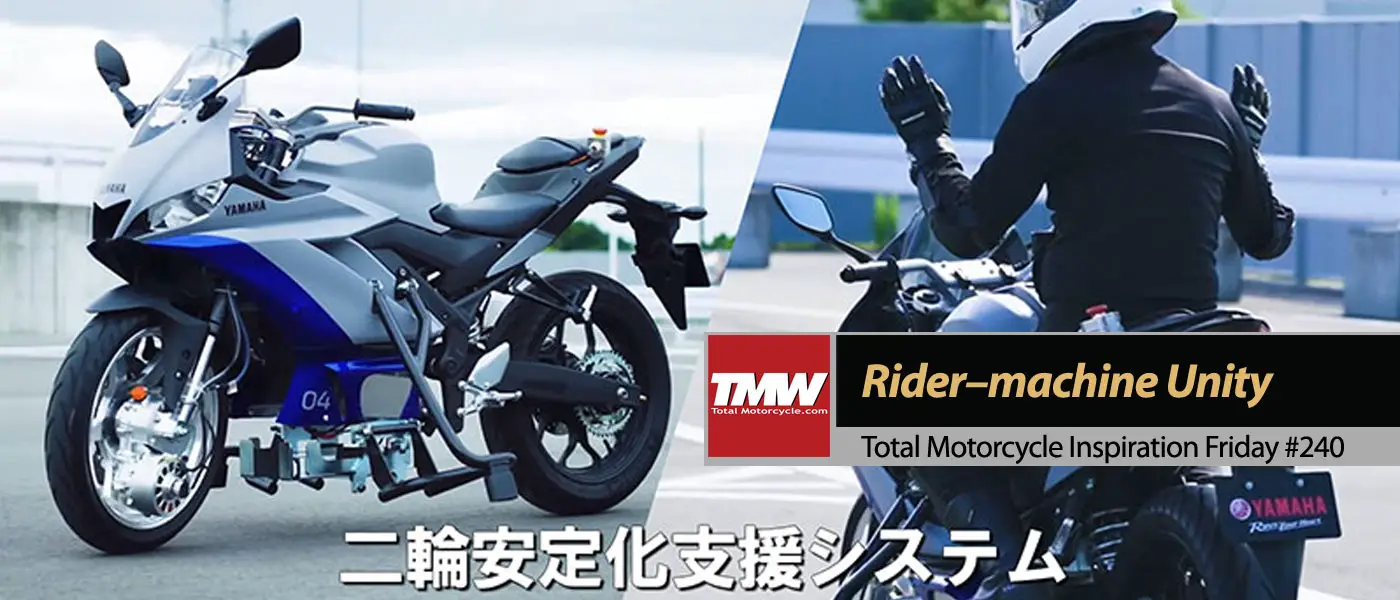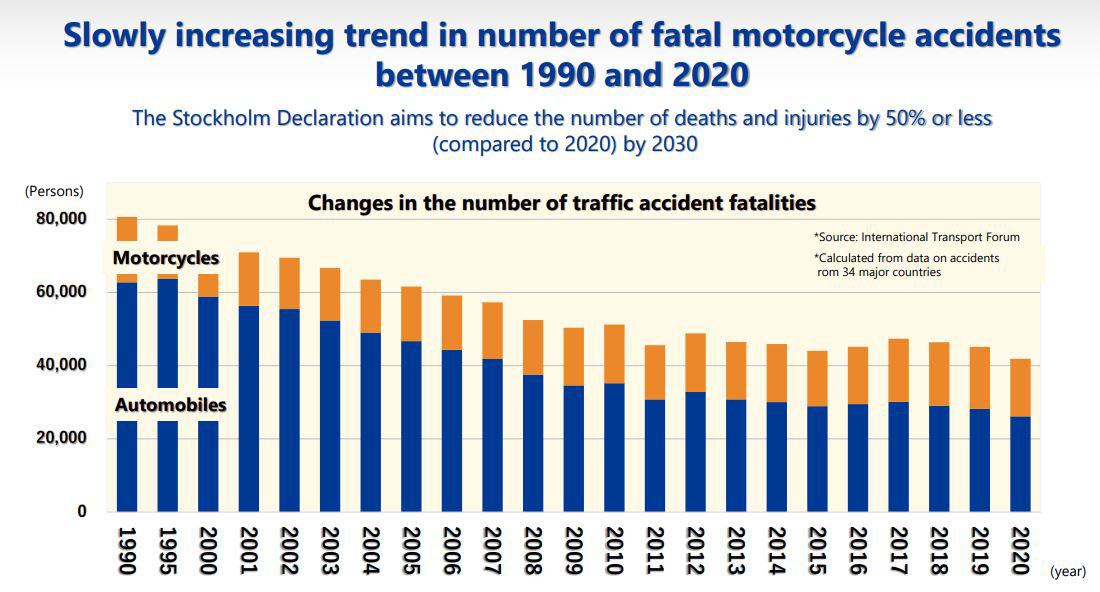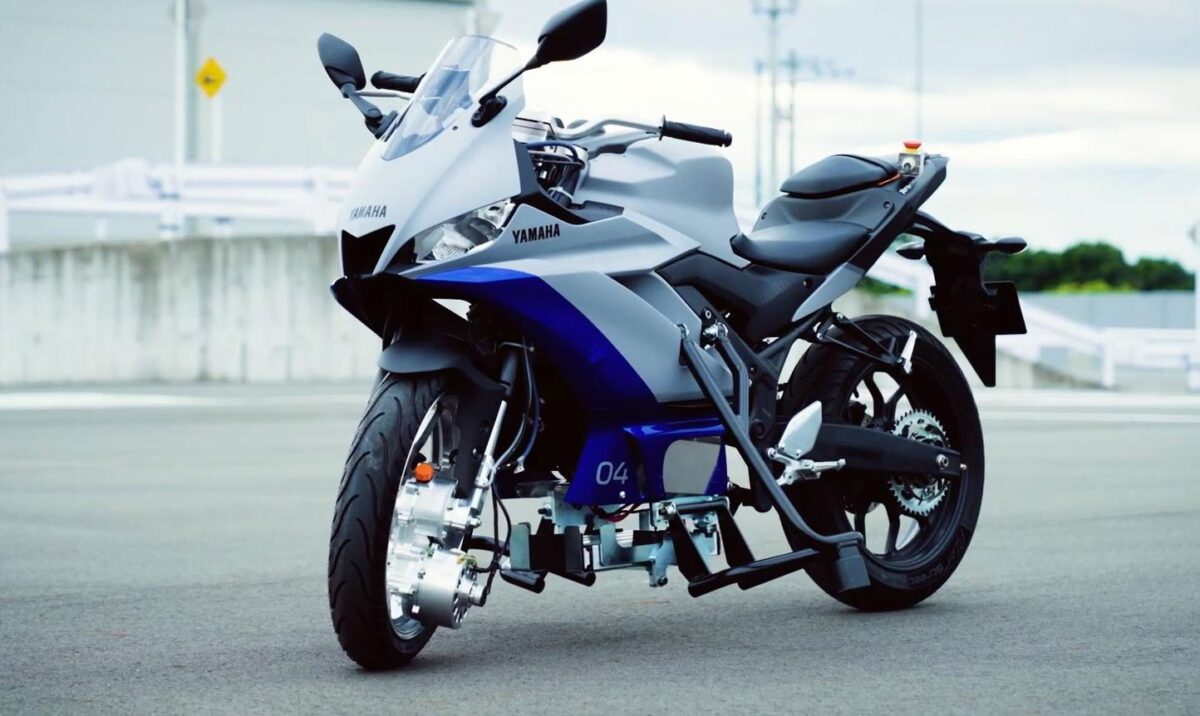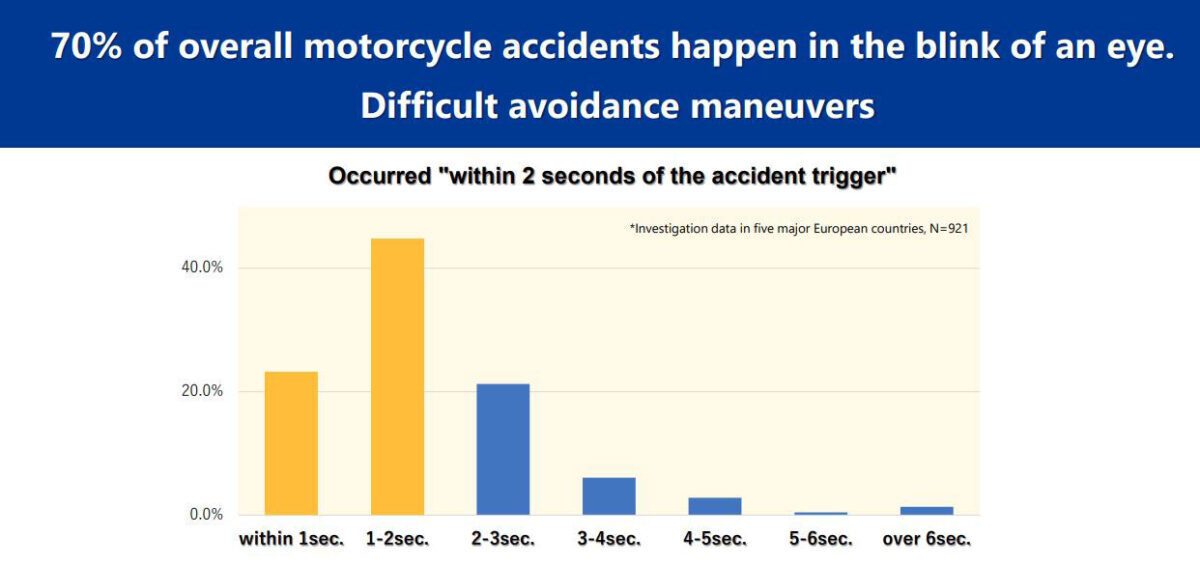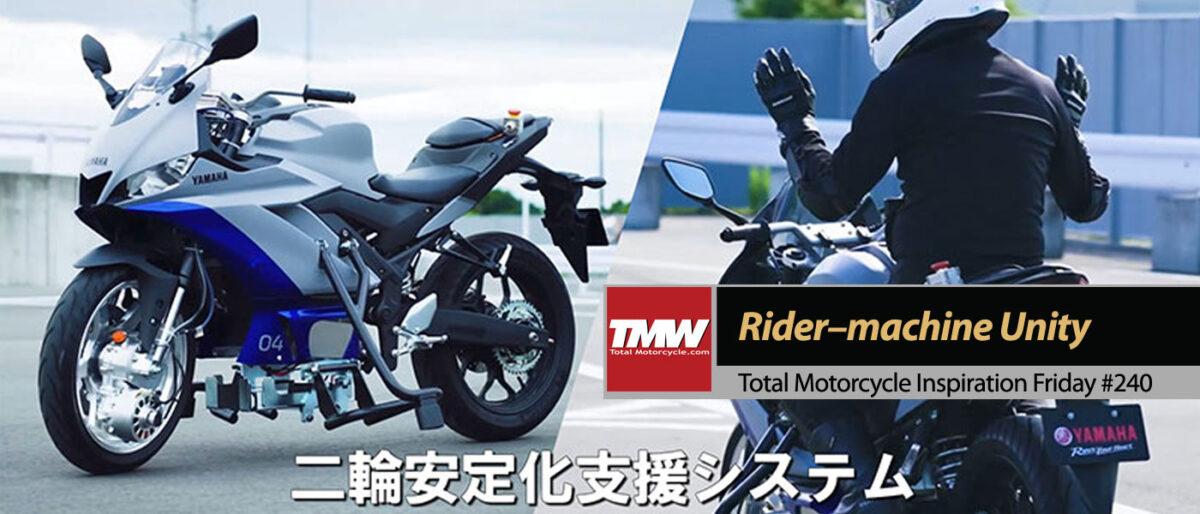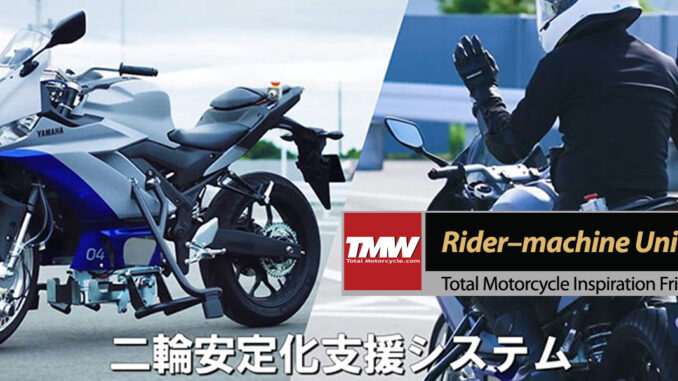
Since 1990, automobile accidents have dropped by 50% and motorcycle accidents hasn’t dropped. As a rider you have 2 seconds to impact. Yamaha wants to change that and it’s called Jin-Ki Kanno x Jin-Ki Anzen. Welcome to week #230 of Total Motorcycle Inspiration Friday; Rider–machine Unity! We have both a fascinating and inspiring read for you this week complete with photos, review and a presentation from Yamaha.
Yamaha wants to create a world free of accidents for riders with three main pillars. 1. Assistant technology. 2. Skill improvement through technology. 3. Rider and motorcycle connectivity.
- With assistant technology, Yamaha has introduced, like BMW, a motorcycle that is 100% fully stable at start and a speed! Based on analyses of accident causes, Yamaha’s development of rider aids is underway according to four vectors: assisted danger prediction, damage prevention and assisted defensive riding, assisted evasive riding maneuvers, and damage mitigation.
- Skill improvement through technology. We will grow the number of touchpoints we have with riders—in both the digital realm and the real world—and provide helpful opportunities to not only improve riding skills but also gain safety-related knowledge and experience while having fun along the way.
- Rider and motorcycle connectivity. By creating systems that inform the rider of surrounding vehicles, traffic rules and conditions, or even predictions of potential risks, we can assist the rider’s own recognition of dangers and decision calls. Advanced Motorcycle Stability Assist System Motorcycle stabilization stabilizes the vehicle even at low speeds allows everyone to enjoy a sense of oneness with the machine in comfort and with peace of mind.
Jin-Ki Kanno is Yamaha Motor’s exclusive development ideal. Technology born from Jin-Ki Kanno seeks to deliver users the seductive exhilaration felt when they truly become one with their machine. Quantifying and fine-tuning this kind of exciting performance, which we call Kanno Seino, and then building it into our products is a solid part of our Yamaha Monozukuri framework, and this development style permeates all of our workplaces.
Jin-Ki Anzen expresses our belief that having people and machines work together in complementary ways can make more sophisticated safety skills and technologies possible. In order to create a safer world of personal mobility, Yamaha Motor will begin working to enhance the human–machine relationship in ways that bring growth and advancements to both.
See the Yamaha Motor: Safety Vision and Technology Briefing right here.
See all the new 2023 Yamaha and 2024 Yamaha Motorcycle Models right here on Total Motorcycle to keep up on the latest in bike technology and what’s new in the zoo!
Total Motorcycle would like to thank Yamaha as well as our 400 million of motorcycle riders and enthusiasts who visit and support TMW for inspiring us to bring you this week’s Inspiration Friday: Rider–machine Unity!
Each week we bring you another Inspiring Motorcycle story to inspire you to get out and ride.
Join Total Motorcycle here and help us by joining Total Motorcycle’s new YouTube Membership and $1/mo Patreon channels. Please help us help riders, support motorcyclists and motorcycling worldwide today.
Developing the Advanced Motorcycle Stabilization Assist System (AMSAS)
Controlling drive and steering forces for rider–machine unity and peace of mind for all motorcyclists
Last year, Yamaha Motor announced its Jin-Ki Kanno x Jin-Ki Anzen Safety Vision, which aims to create a world free of accidents together with our customers. The three pillars of the approach are: 1) Technology that assists with rider recognition, judgment, operation, and damage mitigation, 2) Skills, in which we encourage improvement of users’ riding skills, and 3) Connectivity, where the Cloud is used to provide feedback for safety initiatives. To highlight the Technology pillar in this issue, we spoke with the developers of the Advanced Motorcycle Stabilization Assist System (AMSAS). As it is naturally linked to Jin-Ki Anzen, we asked about its aims and the value it offers.
A Rider Aid to Enhance Stability with Starts and at Low Speeds
Accidents involving motorcycles have been attributed primarily to recognition errors (10%), decision errors (17%), and operation errors (5%) on the part of the rider. Data also indicates that approximately 70% of motorcycle accidents occur within two seconds of the trigger leading to the accident. Based on these analyses of accident causes, Yamaha Motor’s development of rider aids is underway according to four vectors: assisted danger prediction, damage prevention and assisted defensive riding, assisted evasive riding maneuvers, and damage mitigation.
Unveiled last year, AMSAS stabilizes a vehicle’s attitude at low speeds by controlling drive forces and steering forces. “[Its most distinctive feature is] its approach to use an arrangement highly applicable to existing vehicles since it does not require any modifications to the frame,” says Project Leader Akitoshi Suzuki. The prototype system under development uses a production YZF-R25 for its platform and is equipped with a 6-axis Inertial Measurement Unit (IMU) along with drive and steering actuators.
AMSAS is a rider aid that focuses on the instability a motorcycle experiences when starting off or when riding at low speeds, and works to enhance the stability of the vehicle during these moments. “When starting or stopping, the drive actuator fitted to the front wheel aids with stability, and from there up to about 5 km/h, the steering actuator attached to the handlebars takes over,” explains Suzuki. Through the coordination of the two, the mid-development AMSAS prototype vehicle can move at walking speeds without falling over, regardless of the skill level of the rider aboard.
A Technology Platform Adaptable to Various Mobility Applications
Yamaha Motor once made headlines when it unveiled the MOTOBOT—an autonomous motorcycle-riding humanoid robot—and MOTOROiD, a proof-of-concept experimental motorcycle equipped with AI and self-balancing technology. “The R&D for AMSAS began with the idea of bringing the technologies and know-how acquired through developing these two models to customers around the world,” says Suzuki.
Jun Sakamoto, who handles safety strategy at Yamaha, explains the value AMSAS aims to offer: “It’s to create conditions where the rider can focus more on operating their bike, so that everyone can enjoy that sense of being one with your machine. By providing an assist when the bike is more unstable and requires skill to operate, we want to deliver fun rooted in peace of mind to a wide range of riders.”
Yamaha has set a target of reducing the number of fatal motorcycle accidents to zero by 2050 and is ramping up efforts according to the three aforementioned pillars of Technology, Skills, and Connectivity. AMSAS is one technology with the potential to become a pivotal rider aid if used in conjunction with other technologies, like the radar-linked Unified Brake System—the first of its kind in the world—already deployed on the TRACER 9 GT+.
“With the base technologies in place now, we’re halfway to our goal of bringing AMSAS’ value to customers,” asserts Suzuki. He and the team have high aspirations for the technology: “From here on, we’ll be working to downscale the sizes of the various components and so on, as we want to develop it into a platform not just for motorcycles, but one also adaptable to a wide range of other personal mobility applications, like bicycles.”
For Greater Safety in Mobility – Jin-Ki Kanno × Jin-Ki Anzen
Our initiatives to assist safety with Technologies, User Skills, and Connectivity to achieve our Jin-Ki Kanno × Jin-Ki Anzen Safety Vision
Jin-Ki Kanno is Yamaha Motor’s exclusive development ideal. Technology born from Jin-Ki Kanno seeks to deliver users the seductive exhilaration felt when they truly become one with their machine. Quantifying and fine-tuning this kind of exciting performance, which we call Kanno Seino, and then building it into our products is a solid part of our Yamaha Monozukuri framework, and this development style permeates all of our workplaces.
Jin-Ki Anzen expresses our belief that having people and machines work together in complementary ways can make more sophisticated safety skills and technologies possible. In order to create a safer world of personal mobility, Yamaha Motor will begin working to enhance the human–machine relationship in ways that bring growth and advancements to both.
Centering our efforts to elevate safety on technologies, user skills, and connectivity, the Jin-Ki Kanno × Jin-Ki Anzen Safety Vision expresses Yamaha Motor’s unique approach to create a world free of accidents together with our customers, in which users can experience the joy and Kando* that comes from progressing their own skills and abilities while having fun at the same time.
*Kando is a Japanese word for the simultaneous feelings of deep satisfaction and intense excitement that we experience when we encounter something of exceptional value.
Slight Upturn in Motorcycle-Related Deaths (1990–2020)
While deaths from car accidents are slowly declining, the number of fatalities from motorcycle-related accidents is showing a slight increase.
Causes of Motorcycle-Related Accide
Some 30% of motorcycle accidents are caused by error or negligence on the part of the rider, but over 50% are due to car driver error or negligence. The first step we must take is to eliminate errors by riders in identifying potential dangers, making sound judgments, and skillfully operating the motorcycle to avoid said dangers.
Furthermore, we must work to improve the conspicuity and recognition of motorcycles by car drivers. It is easy for motorcycles to enter the blind spots of cars and trucks, plus they often appear to be moving slower or are farther away than they actually are, and this leads to errors in driver recognition and decision.
Accidents Occur in a Flash and Successful Avoidance Takes Skill and Knowledge
From the moment the cause of a future motorcycle-related accident arises, 70% of them occur within just two seconds afterwards. We also know that the majority of riders are currently unable to make the right maneuvers to prevent the accident in such a short span of time. Additionally, it is no easy feat for a rider to do this properly while facing imminent danger. In these kinds of situations, instead of solely relying on user decision and skill to perform the right evasive maneuvers, it is essential that we try to help with rider-assistive technologies.
Technologies
By creating systems that inform the rider of surrounding vehicles, traffic rules and conditions, or even predictions of potential risks, we can assist the rider’s own recognition of dangers and decision calls. And when riding at low speeds where a high sense of balance is needed, technology can assist the rider’s inputs to keep vehicle behavior stable and help in ascertaining the conditions of the surroundings. Furthermore, should an accident unfortunately occur, other systems can help to reduce damage or injury, such as deploying onboard rider protection devices or sending incident reports to emergency services automatically.
User Skills
We will grow the number of touchpoints we have with all our customers—in both the digital realm and the real world—and provide helpful opportunities to not only improve riding skills but also gain safety-related knowledge and experience while having fun along the way. To do this, we will continue our work through the Yamaha Riding Academy, but also introduce more on-demand and microlearning content so that customers can easily participate in riding safety classes.
Connectivity
We will emphatically raise the level of connectivity between riders and their vehicles, collect data on vehicle use and operating conditions, and aim to feed that information into more Jin-Ki (human–machine) safety initiatives.
Technology
Advanced Motorcycle Stability Assist SystemMotorcycle stabilization assist system using drive force and steering force control Provides riders with security and comfort.
Control technology that stabilizes the vehicle even at low speeds allows everyone to enjoy a sense of oneness with the machine in comfort and with peace of mind.
Electronic control system
Equipped with 6-axis Inertial Measurement Unit along with drive and steering actuators. Achieves stabilization at low speeds
Adopts a structure that is highly applicable to existing models without changing the frame
Skills
Safety Classes Expansion Experiential-type safety program: Yamaha Riding Feedback System Analyzes each rider’s riding conditions and provides feedback on points to improve skills
Jin-Ki Kanno
Introducing Yamaha Motor‘s development ideal and the stories behind technologies
At Yamaha Motor, we have a long-standing exclusive development ideal called Jin-Ki Kanno.
Jin-Ki Kanno Lead-up to Establishment: From 1980 to 2015
Technology born from Jin-Ki Kanno seeks to deliver users the seductive exhilaration felt when they truly become one with their machine.
Quantifying and fine-tuning this kind of exciting performance, which we call Kanno Seino, and then building it into our products is a solid part of our Yamaha Monozukuri framework, and this development style permeates all of our workplaces.
Definition of Jin-Ki KannoThe seductive exhilaration felt when one with the machine that is shared as a baseline when quantifying and integrating it into a Yamaha’s performance.


